B10 Eastern Karameikos, 3 miles per hex
B10 Night’s Dark Terror is surely one of Mystara’s best-loved adventures. It also includes some of the most detailed maps of Karameikos in any official source, even providing ridge lines for the Black Peak Mountains to the north of the realm.
The region saw further development in later modules, as well as of course in GAZ1, which was released the following year.
Update January 2025: At the suggestion of Troy Witthoeft over on the Facebook Mystara group, I have added a players’ version of the replica map with all of the DM information removed. This isn’t strictly a replica, but I’m placing it here, where DMs looking for such a map are most likely to find it.
Replica Map (May 2019)
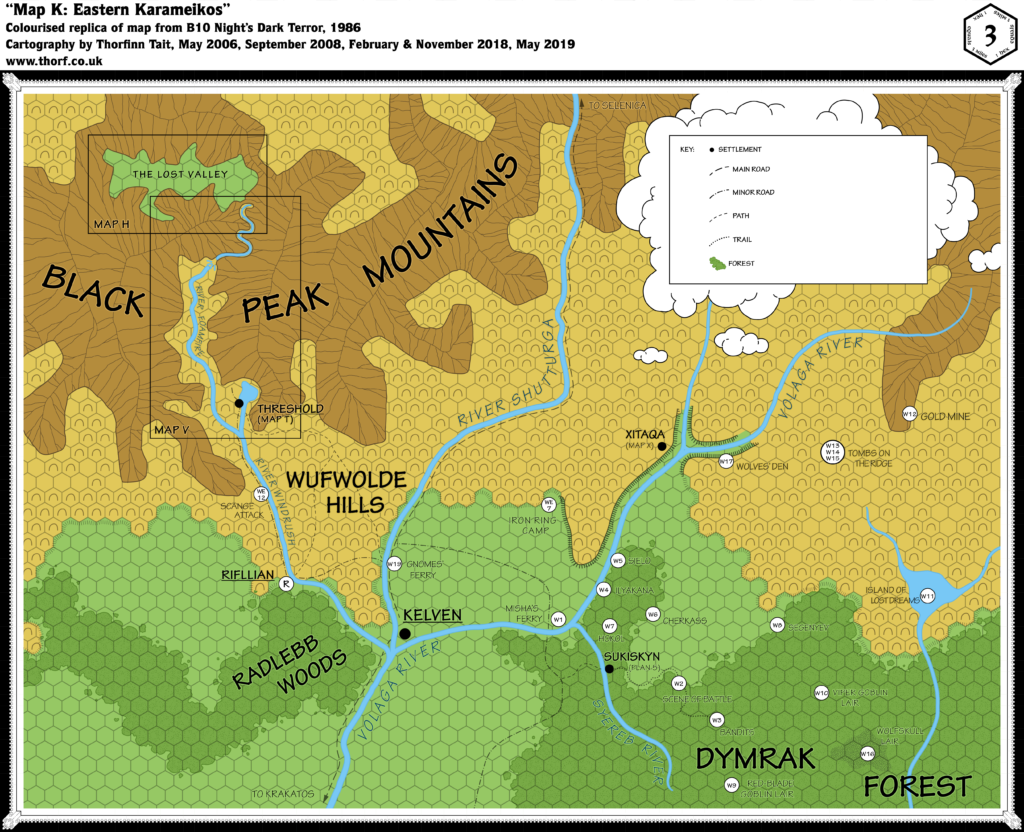
Players’ Map (January 2025)
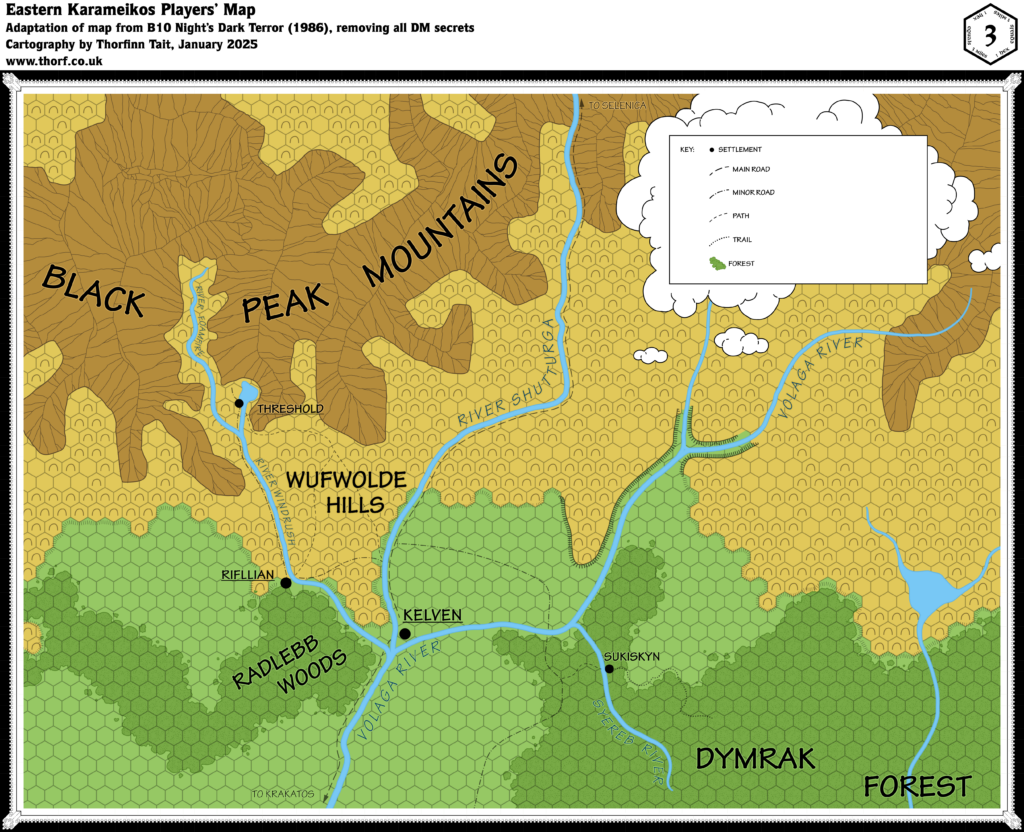
Sources
- B10 Night’s Dark Terror (1986) (PDF at DriveThruRPG)
- Map K: Eastern Karameikos, inside cover (Cartography by Geoff Wingate)
Chronological Analysis
This is Map 40. It was published in February 1986. The updated version of this map has not yet been released. See also Appendix C for annual chronological snapshots of the area. For the full context of this map in Mystara’s publication history, see Let’s Map Mystara 1986.
The following lists are from the Let’s Map Mystara project. Additions are new features, introduced in this map. Revisions are changes to previously-introduced features. Hex Art & Fonts track design elements. Finally, Textual Additions are potential features found in the related text. In most cases, the Atlas adopts these textual additions into updated and chronological maps.
Additions
- Islands — The Island of Lost Dreams is labelled on the map, though the isle itself is hidden beneath its label. See Textual Additions for more on the Island.
- Lakes — Threshold is shown to be on the southern edge of a lake. This is the first appearance of the full lake on a map; previously the edge of the lake appeared on the Expert Set Threshold map, and it was also referenced in the text. The lake remains nameless for now.
- Mines — The Gold Mine here is the first mine to be marked on a map of Mystara. It lacks a symbol, instead having a key number.
- Mountains — The Black Peak Mountains have been given ridge lines, although it is unclear exactly what they are intended to mean. (See this thread at The Piazza for discussion of this issue.)
- Plateaus — There is an area with plateaus and ravines along the flow of the Volaga River in the east.
- Rivers — The Syereb River is entirely new, as is the river system around the lake with the Island of Lost Dreams. The names Volaga River, River Shutturga, River Windrush, and River Foamfire are all new names given to existing rivers, but see also Revisions below.
- Settlements — Sukiskyn and Xitaqa. A wealth of other features is marked throughout the map, but with keyed numbers and letters rather than symbols; it’s unclear from the map alone which of these may be settlements: Rifllian, Sielo, Ilyakana, Hokol, Cherkass, Segenyev, Viper Goblin Lair, Wolfskull Lair, Red-blade Goblin Lair. There are also smaller or more temporary locations such as camps and attack sites: Bandits, Gnomes’ Ferry, Iron Ring Camp, Misha’s Ferry, Scange Attack, Tombs on the Ridge, Wolves’ Den.
- Terrain — Wufwolde Hills, Radlebb Woods and Dymrak Forest are all named for the first time, although of course the terrain itself appeared on maps as early as 1981.
- Trails & Roads — An extensive system of roads and trails are shown throughout the map, divided into an unprecedented four levels: main roads, minor roads, paths, and trails. All but the main road (Krakatos-Kelven-Selenica) and part of the Kelven-Threshold road are new.
- Waterfall — Although it’s unlabelled and the symbol lacks an entry in the key, the River Foamfire’s course is interrupted by what seems likely to be a waterfall as it leaves the mountains and enters the valley.
Revisions
- Rivers — The Volaga River was previously labelled River Highreach, all the way back in 1981’s X1 map. It also wasn’t clear which of the sources was considered the main river, but B10 explicitly shows it to be the easternmost source. The River Foamfire has been extended up through the mountains to the Lost Valley. The courses of the rivers remain largely the same, though they vary by as much as two or three 3 mile hexes in places. The confluence point between the Windrush, the Shutturga and the Volaga has been moved approximately 4 miles north-northeast.
- Spelling — Kelven; previous maps had both Kelvin and Kelven, with the former slightly more prevalent, but B10 uses Kelven throughout.
- Terrain — The terrain on this map lines up reasonably well with that of previous 6 mile per hex maps, although not perfectly. Revisions are assumed to be the result of being able to show more detail at the larger scale used in this map.
Hex Art & Fonts
- Fonts — Hand-written text in a clear, architect-like style. The replica maps use Tekton Pro.
- New Symbols — Ridgelines (lines drawn on outlines of mountainous areas), Waterfall (three splashing lines breaking a river’s course), Hill edges (dotted line between hills and plains); Main Road (dashed line), Minor Road (alternately dashed/dotted line), Path (small dashed line), and Trail (dotted line) are not exactly new but the hierarchy defined here is unique to this map.
Textual Additions (B10 1986)
- Bridges — There is a bridge crossing the Syereb River directly west of Sukiskyn; in fact, the homestead is located at a bend in the river (pages 7 and 9). There are four bridges on the path to Hutaaka: two intact, across the Gorge and the High Bridge; and two broken, the Fallen Bridge and before the Gate to Hutaaka.
- Camps — A number of camps are marked in B10. These are no different from lairs, really.
- Bandits (W3) — A camp with 5 bandits, including “Bandit Leader” Fyodorll. (Page 12)
- Iron Ring Camp (WE7) — This camp seems to be too temporary to warrant marking on the map. (Page 30)
- The Scange Camp (WE12) — A total of 26 bandits including their leader, Hrothgar. (Page 33)
- History — The Hutaakan Empire “extended over the lands now covered by northern and eastern Karameikos”, “many millennia” ago. Their realm “expanded from the valley of their birth out onto the lowlands”, where they conquered the “primitive human tribe” known as the Traldar. “Hutaakan civilisation flourished both inside and outside the valley. As it was reaching its zenith, the lowlands were invaded by gnoll hordes.” At this point the Hutaakans withdrew to their valley with their human minions. Subsequently, the Traldar revolted, beginning “years of bitter inter-racial warfare” in which “most of the valley’s population perished”. The struggle continues to this day. (All page 4.)
- Islands — Map W11 shows the exact shape of the Island of Lost Dreams, but since the island is only about 550 yards long (at a 100 yards per hex scale), it’s somewhat beyond the scope of this project. The Temple marked on the map is referred to as “Ancient Building” in the text; it’s said to be in the centre of a grassy clearing in the woods (page 17). The “a” on the map is a pixie village (population 14). The pixies are known as the “Ilya”. (Pages 16-17)
- Lairs — The pre-adventure state of the lairs detailed in B10 should be as follows:
- Bald Dog Lair — This orc lair is said to be “Underground in Zargash Mountains (not on map)” (PSVI).
- Dark Web Lair (W12) — These orcs’ lair is said to be “on the far side of the mountain spur” from the Gold Mine (page 17). There are 22 orcs (page 18).
- Death’s Head Lair — “Caves (not marked) overlooking the valley of the Foamfire River” are the lair of the Death’s Head gnolls. (PSVI) There are 175 gnolls, including gnoll chieftain Gragszt, who is also described as their “warlord”, as well as 4 ogres (page 41).
- Red-blade Lair (W9) — Before the adventure, this lair was home to 51 goblins, including their “king”, Gnhass. This includes 3 noted to have fallen at Sukiskyn before the adventurers arrived. (Pages 7 & 10)
- Viper Lair (W10) — Since it is noted that 3 goblins were killed at Sukiskyn, the tribe originally consisted of 20 goblins. Their leader is unnamed. (Pages 7 & 10)
- Wolves’ Den (W17) — a “den of caves in a rocky outcrop by the Volaga river”, home to 2 werewolves and 11 wolves, led by Bailakask (page 23).
- Wolfskull Lair (W16) — Pre-adventure, 29 goblins, including their “king”, Kloss. (Page 10)
- Lakes — The Lake of Lost Dreams, in the midst of which the Island of Lost Dreams lies, is named in the text (page 16). (See also Islands above.) The (still nameless) lake on whose shores Threshold sits has rather different sizes: the 3 mile per hex map has it about 8 square miles, while the 2 mile map has it about 6 square miles, and slightly further north. The Atlas tends to view larger scale maps as the best sources, so I have gone with the smaller lake from the Foamfire Valley map.
- Mines — The Gold Mine (W12, pages 17-19) is owned by a gnome called Vissaryon, who operates it with his brother Tekaryon and 12 dwarf miners. (Pre-adventure figures.) It is also home to the Dark Web orcs. (See Lairs above.) There are Hutaakan ruins in the caves.
- Races — B10 introduces a large range of named tribes and clans — far more than any previous module, and they are far more detailed, too.
- The Callarii elves reside in and around the village of Rifllian. Their symbol is a white horse. (Page 5) They also live elsewhere in the Radlebb Woods; Callarii was “their epic heroine”, and appears in their symbol as a “sad elven woman on a white horse” (both PS VI).
- A second clan, the Vyalia elves, live in “tree-houses in forest S.E. of Lake of Lost Dreams (not on map).” (PS VI) This last comment can be taken two ways: either the tree-houses are not shown on the map, or the Vyalia elves live off the edge of the map. It seems reasonable to assume it’s the former.
- The three goblin lairs on the map are given goblinoid names in addition to their common tongue names: Red-blade (Gnhasska) goblins, Wolfskull (Kloss-lunk) goblins, and Viper (Jaggadash) goblins (page 7, PS VI). These names are apparently based on the goblin “kings” leading the groups: Gnhass and Kloss (page 10). A fourth tribe is the Yellow-fang (Faz-plak) goblins (PS VI). (See also Lairs above.) These goblins account for the Goblins label in the Dymrak Forest area on previous maps.
- Two orc tribes are mentioned: the Black Web (Nyy-akk) orcs (page 17 & PSVI) and the Bald Dog (Pftark) orcs (PSVI). The Black Web orcs can be found in the Gold Mine, while the Bald Dog orcs are a random encounter — “a raiding party from the mountains” (PSVIII). (See also Lairs above.) These orcs may account for the Orcs label near these mountains on previous maps.
- The Death’s Head (Galt-kalat) gnolls (PSVI) claim most of the Foamfire Valley as their territory: “A few miles from Threshold, the route along the Foamfire enters the lands claimed by the Gnolls of the Death’s Head. … Further upstream, the gnolls’ territory ends at a majestic waterfall where the Foamfire crashes down from a narrow mountain pass.” “The lands of the Death’s Head gnolls begin at the point where the Foamfire valley narrows north-west of Threshold.” (Page 40) (See also Lairs above.)
- Rivers — The rivers of Karameikos are quite a focus in B10, with quite a lot of mentions in the text. PSI makes it clear that B10’s conception of the confluence of the rivers Windrush, Shutturga and Volaga is indeed at the same place, and that Kelven is located there — agreeing with the hex maps but contradicting the Players’ Map.
- Foamfire — “The Foamfire river is not navigable by watercraft.” (Page 38)
- Volaga — The first place upriver from Kelven where the Volaga River can be crossed is at Misha’s ferry, where a trade route crosses the river (page 6). “Upstream from Sielo, the Volaga river may be crossed easily at the ford, or by swimming characters, or those on horseback.” (Page 24)
- Windrush — This river is navigable from Threshold to Rifllian and beyond to Kelven. (Page 32)
- Settlements — B10 introduces not just towns and villages but also homesteads and ruins; there are homesteads and forest lumber-camps east of Kelven (page 5). Many of these are destroyed during the adventure, often before the PCs can visit, meaning that their status on a map will depend on whether it is pre-adventure or post-adventure. Since the Atlas in most cases deals with the pre-adventure world, I am marking these accordingly.
- Cherkass (W6 on the map) is a homestead like Sukiskyn, but it is destroyed during the adventure. (Page 15)
- Gnomes’ Ferry is a ferry and hostelry on the Shutturga river run by 5 gnomes (page 41).
- Hokol (W7 on the map) is another homestead like Sukiskyn, but it is destroyed during the adventure. (Page 15)
- Kelven is “a thriving frontier town that has grown up rapidly, following its establishment at the point where the rivers Windrush, Shutturga, and Volaga meet” (PSI). It has a wharf where riverboats dock, and is therefore explicitly located on a river — the Volaga River, to be precise (page 6). This implies that it is either located between the Volaga and the Shutturga, or else it straddles the Shutturga (surrounding a bridge or bridges for example) so that it sits by all three rivers. It’s worth noting here that since its original appearance on Karameikos maps it has been depicted as being between the Volaga and the Shutturga. Page 32 implies that there is river traffic between Threshold, Rifllian and Kelven along the Windrush river. Regardless of the exact location and configuration of Kelven, it seems clear that it has access to all three rivers.
- Ilyakana (W4 on the map) is a lumber camp. It is destroyed by goblins during the adventure. Population is uncertain, though “most of the people there” were said to be killed, with four survivors, suggesting a population of at least ten. (Pages 12 & 15)
- Misha’s Ferry is a single cabin by a jetty on the Volaga river, with a single resident (Misha) who lives with her pet bear. She is killed before the PCs can meet her. (Page 6)
- Rifllian is a village, populated by Callarii elves (PS VI). “Rifllian is a small elven village of 170 inhabitants on the western bank of the Windrush river. The village is an outpost of the Callarii elves…” “Most of Rifllian’s inhabitants are Callarii elves.” (Page 32)
- Segenyev (W8 on the map) is another homestead like Sukiskyn, but it is destroyed during the adventure. (Page 15)
- Sielo (W5 on the map) is another lumber camp. Like Ilyakana, it is attacked and destroyed during the adventure. Population is unknown. (Page 15)
- Sukiskyn is “one of several fortified homesteads in the wilderness east of Kelven”, population 12 humans at the start of the adventure (PS III).
- Threshold “lies on the shores of a small lake” (page 34), though the town map in Expert 1983 shows that it is slightly removed from the lake; B10’s town map has the lake cropped out entirely as it is more zoomed in on the town itself. (See Analysis below for more on this.) “Built primarily of wood (a major resource in the area), it is home to about 500 humans and 50 demi-humans.” (Page 34) This is exactly in line with previous figures. “Threshold is ruled by … Patriarch Sherlane, from his lakeside castle of Tarnskeep.” (Page 34) Tarnskeep appeared on the Expert map of Threshold.
- Tombs on the Ridge (W13-15) are “three ancient burial mounds, standing on a prominent ridge” (pages 19-20).
- Xitaqa was marked on the map, but in the text is revealed to be the ruins of an “ancient Hutaakan settlement” (pages 4-5). The Yellow-fang (Faz-plak) goblins as well as the Bloodhead (Vlackkag) hobgoblins have their lairs here (PSVI). “Between the northern bank of the river and the escarpment on which Xitaqa stands is a level plain.” (Page 24) “The rambling, ancient, Hutaakan settlement of Xitaqa was built in a knot of winding, steep-sided, gullies eroded into the escarpment above the Volaga river.” (Page 25)
- Terrain — B10 added a number of features to the by-now-familiar terrain of Karameikos:
- The Lost Valley is also known as the Lost Valley of Hutaaka, and Hutaaka — The Lost Valley. Page 4 even notes that the name of the race is taken from the name of the valley, “where they originated”.
- The references to moors in B10 all seem to confirm the interpretation of the word as British English. (Pages 5, 23 and 30.) Horses live there along with Loshad the Chevall, and are described as “galloping away over the moors” (page 30) — hardly a fitting description if the word is taken to mean “fen” or “bog”. In any case, as of 1986 there is no special map symbol for moors — note that the Players’ Map just uses a grass symbol, while the DM’s maps have hills — so for now let’s just use the label.
- The Zargash Mountains appears to be the name of the spur of the Altan Tepes featured in the far east of the 3 mile per hex map, with the Gold Mine. (Pages 16 & 17)
- The Petrified Forest, deep in the Dymrak Forest, is “a dismal valley smitten centuries ago by a magical blight that turned every living thing — plant or animal — to stone” (page 20).
Join in the Discussion at The Piazza
Come and join in the discussion about this map at The Piazza, where I am holding a “read through” of the Let’s Map Mystara project.
Maps of Eastern Karameikos
With thanks to Troy Witthoeft for suggesting the Players’ Map.

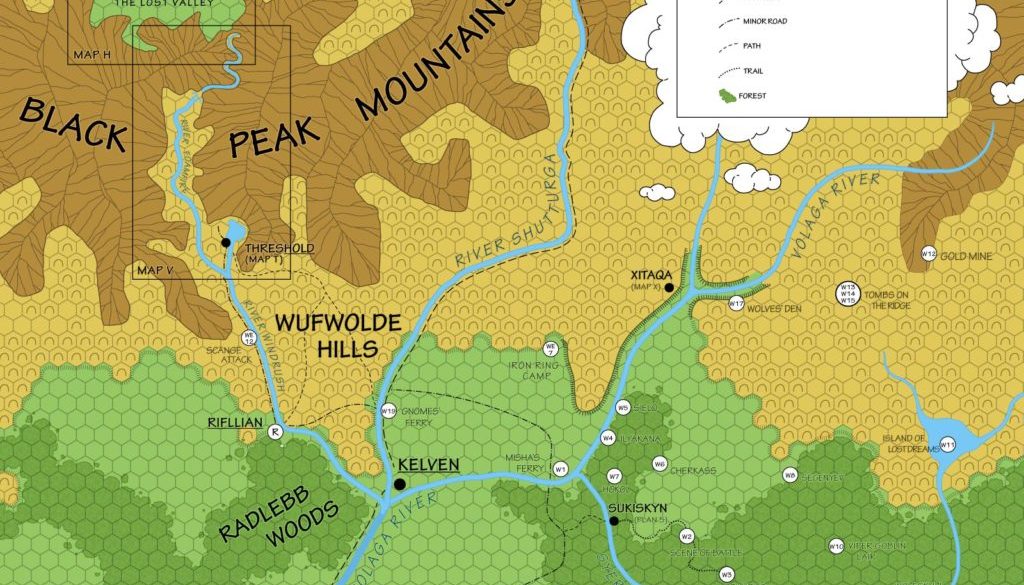
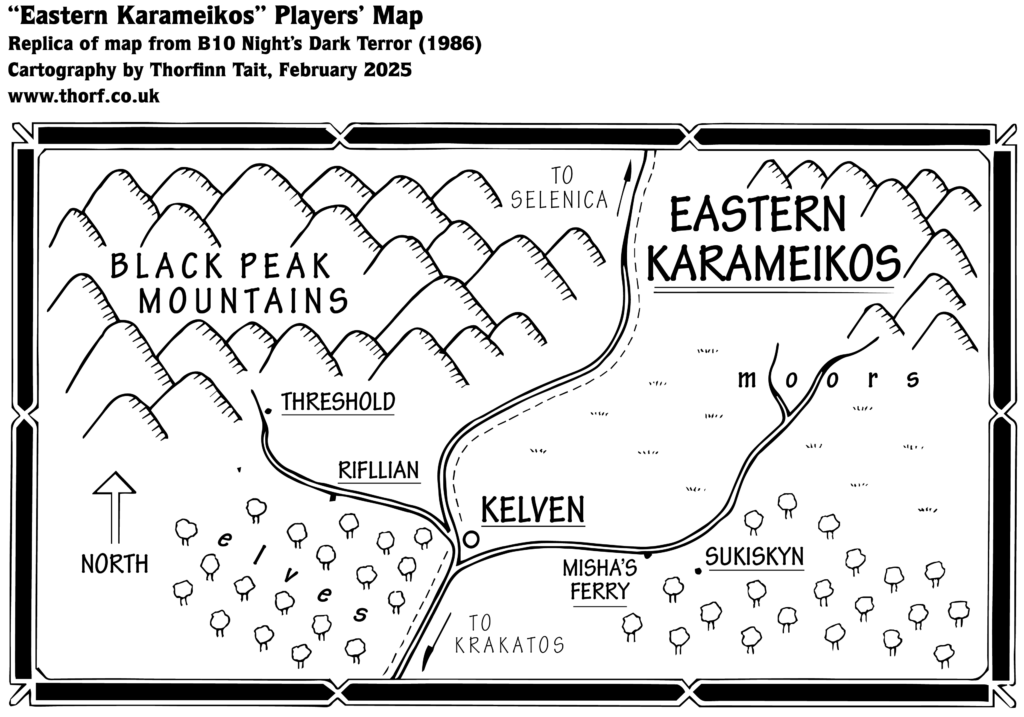
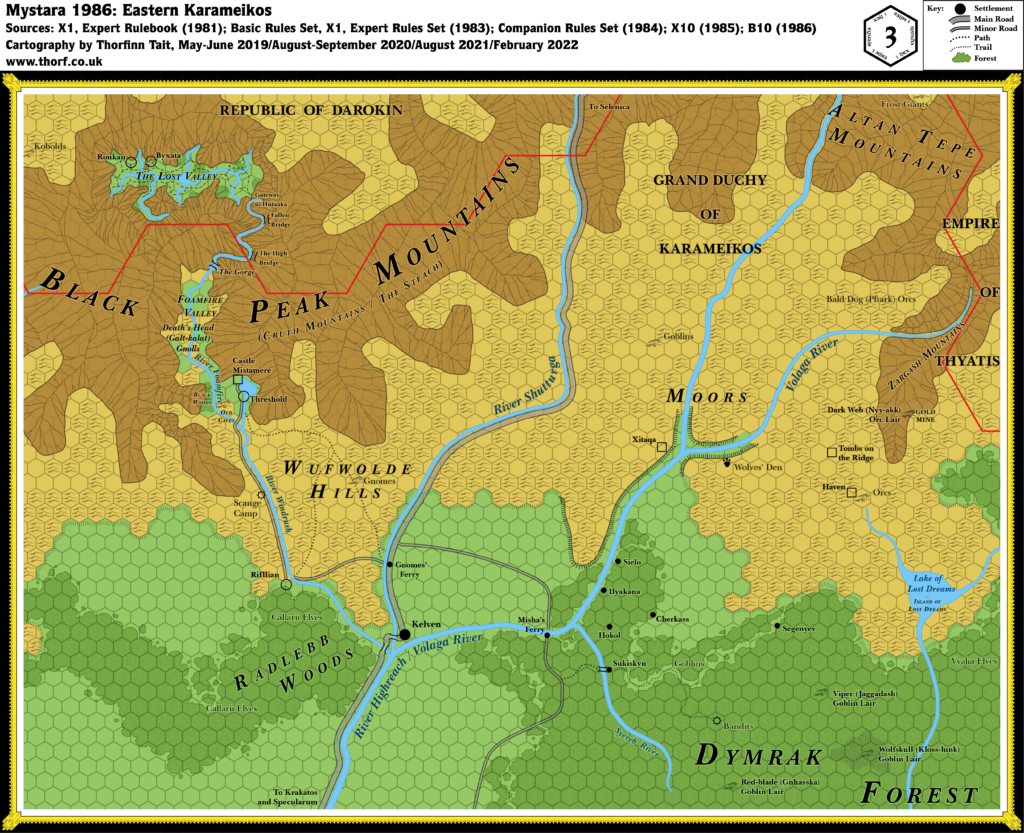
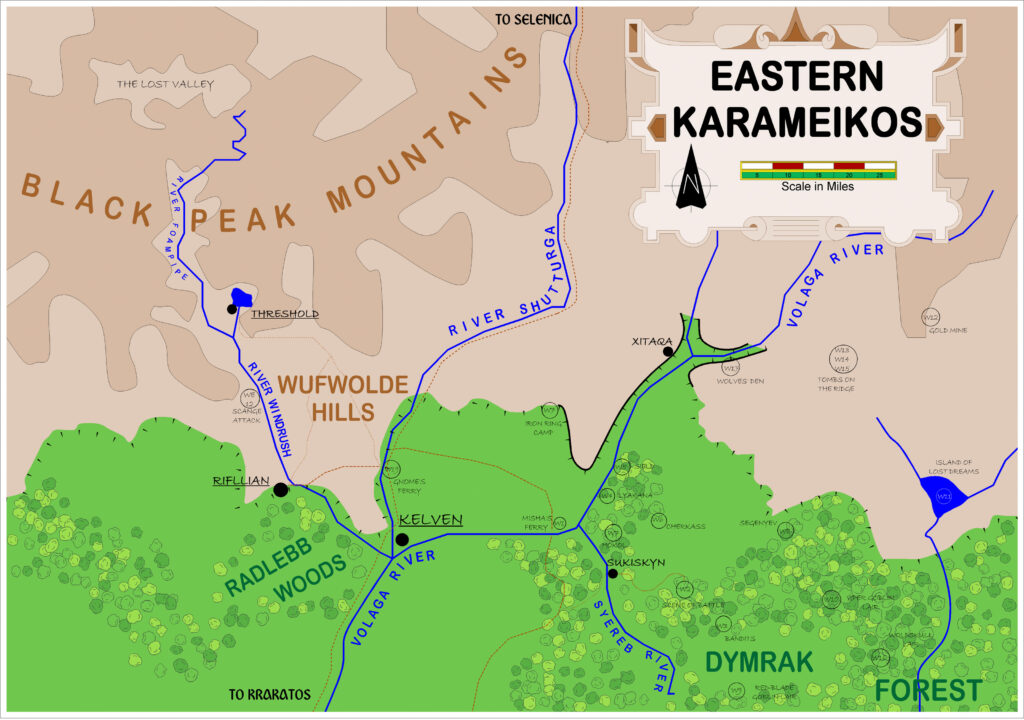
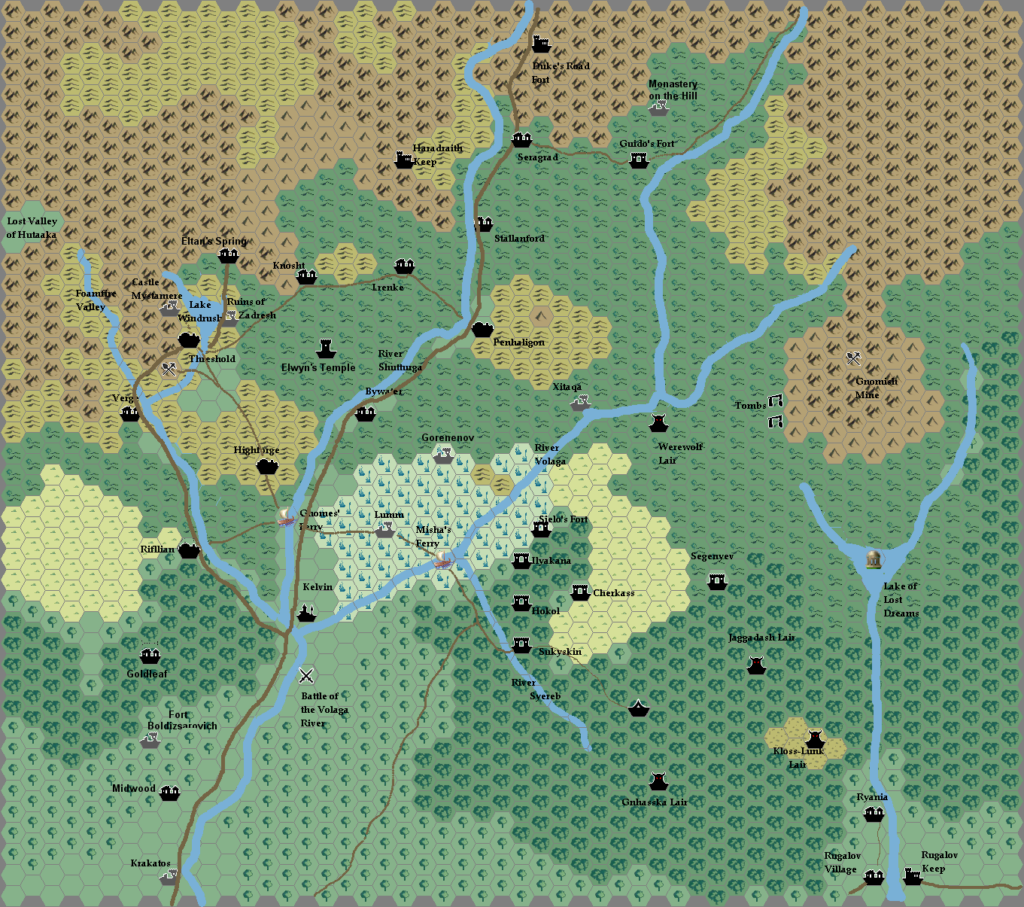
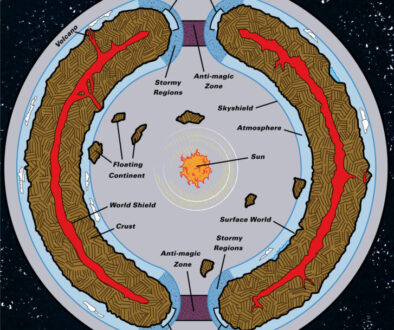
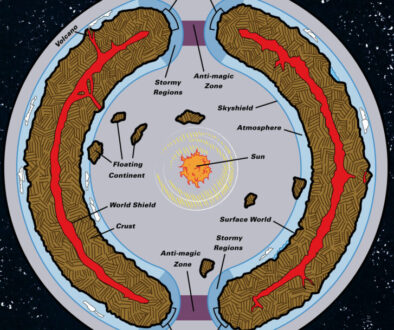
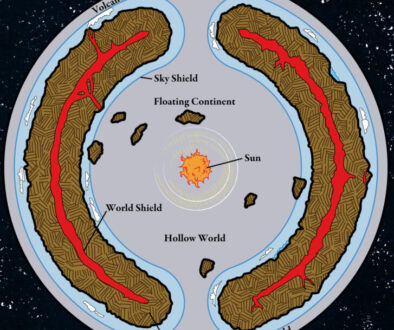
12 February 2018 @ 4:31 am
This map is on the inside cover of the module. A players map showing the locations of the moors is in the middle of module somewhere, I think it is on the opposite page of the calendar. All other maps are on a giant foldout, one side is sukiskyn and the other has all the encounter area maps.
12 February 2018 @ 9:44 pm
Thanks! I don’t think I ever managed to find a physical version of B10. All I have is the PDFs, where it’s not entirely obvious what goes where.
Interesting to hear about the moors — I was wondering if those were an invention of GAZ1, or what. Glad to hear that’s not the case.
28 January 2025 @ 9:51 pm
Hi Thorfinn,
It’s long time I think we (rectius: you) should rotate by 90 degree the hex grid of B10 maps.
I think this will allow to DM and players to locate more easily the places of the B10 on the maps of Gazetteers and the other modules
ok… we know that there are several differences, starting from the direction of the rivers and so on; but this way it would be easier to check the distances between the places added by the B10 module and the other places that we already know by other modules and expert set, such as Penhaligon, Kelven and the legendary Threshold.
May you realize B10 maps replica, with this single update? Just rotating maps by 90 degree …
You will have a new category for your maps also!! 😀
Great Job!
Faber
28 January 2025 @ 9:52 pm
Hi Thorfinn,
It’s long time I think we (rectius: you) should rotate by 90 degree the hex grid of B10 maps.
I think this will allow to DM and players to locate more easily the places of the B10 on the maps of Gazetteers and the other modules
ok… we know that there are several differences, starting from the direction of the rivers and so on; but this way it would be easier to check the distances between the places added by the B10 module and the other places that we already know by other modules and expert set, such as Penhaligon, Kelven and the legendary Threshold.
May you realize B10 maps replica, with this single update? Just rotating maps by 90 degree …
You will have a new category for your maps also!! 😀
Great Job!
Faber